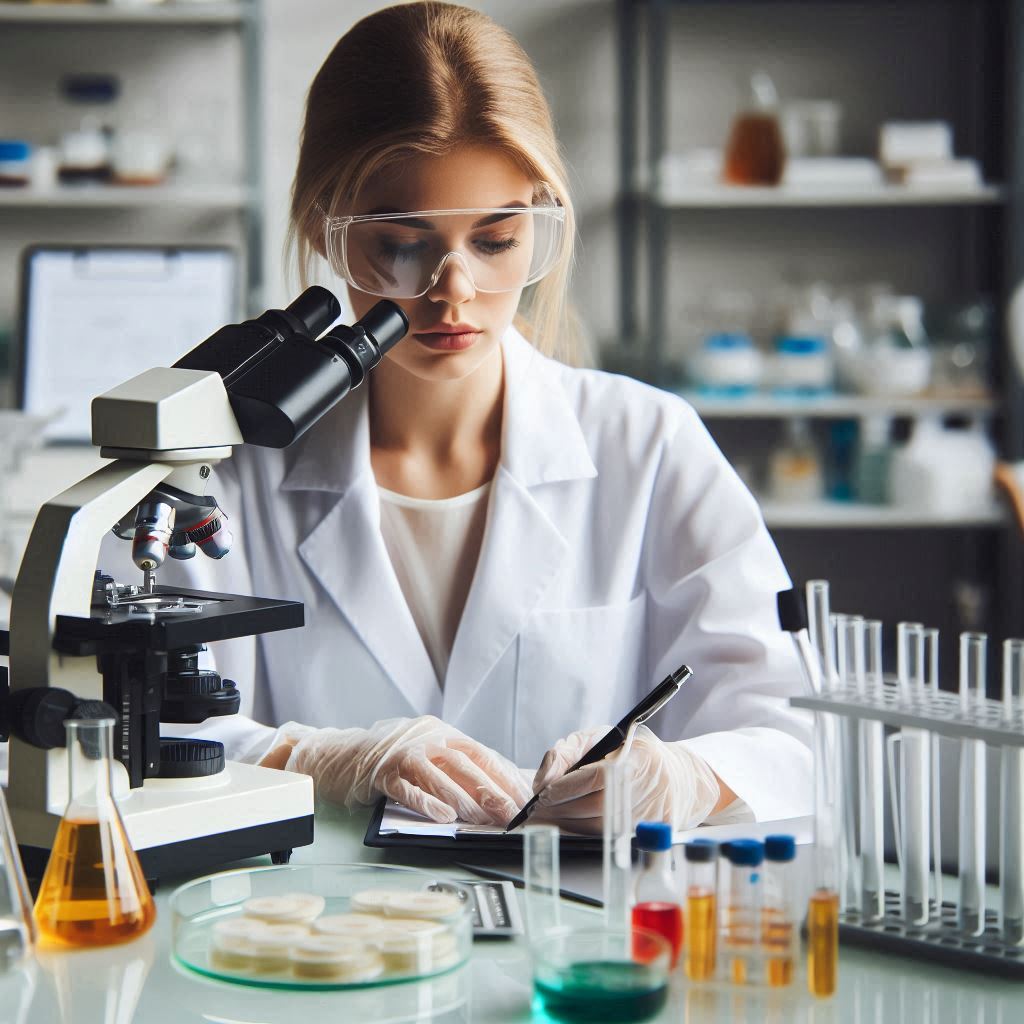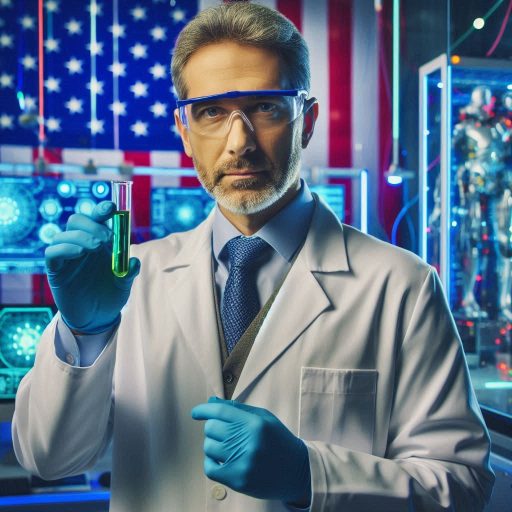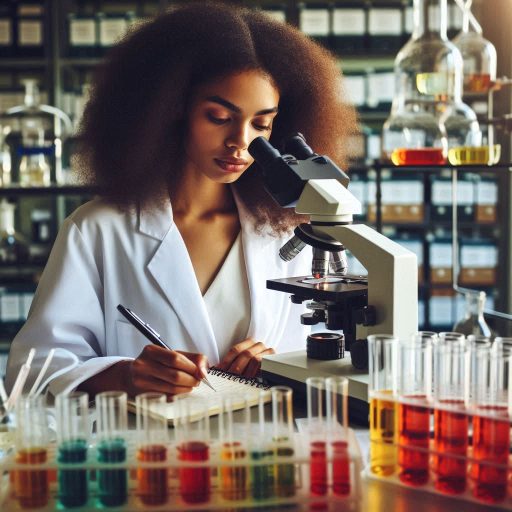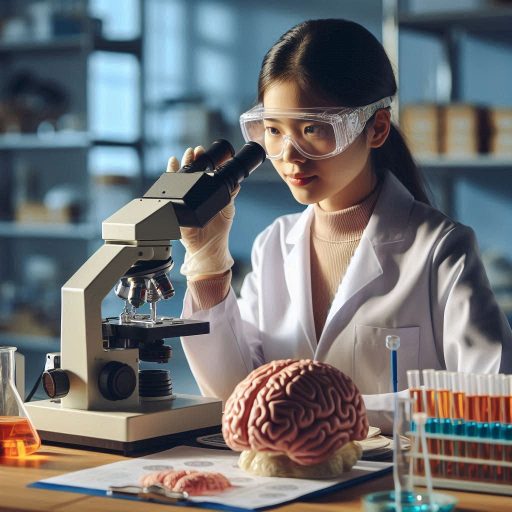Introduction
Microbiologists play a crucial role in combating infectious diseases, significantly impacting public health.
Their expertise is vital for understanding pathogens and their interactions with humans.
By studying microorganisms, microbiologists develop effective prevention and treatment strategies.
Their work ultimately saves lives and protects communities.
Microbiologists investigate various types of microorganisms, including bacteria, viruses, fungi, and parasites.
They analyze how these pathogens spread and cause diseases.
Using advanced techniques, microbiologists identify and characterize these microorganisms, which is essential for diagnosing infections.
Understanding the biology and behavior of pathogens allows them to develop targeted interventions.
In addition to identifying pathogens, microbiologists work on developing vaccines and antimicrobial therapies.
They collaborate with pharmaceutical companies and research institutions to create effective treatments.
These efforts are critical in preventing outbreaks and controlling the spread of infections.
By employing innovative research methods, microbiologists help ensure a healthier future for society.
Microbiologists are essential in the fight against infectious diseases.
Their ongoing research and commitment to public health contribute significantly to preventing and treating infections.
Role of microbiologists in early detection of infectious diseases
How Microbiologists Use Various Methods to Identify and Analyze Pathogens
Microbiologists play a crucial role in the early detection of infectious diseases.
They use various methods to identify and analyze pathogens effectively.
By employing these techniques, microbiologists help control disease outbreaks and protect public health.
One primary method microbiologists use is culture testing.
They grow microorganisms from samples, such as blood or urine, in controlled laboratory settings.
This process allows them to observe and identify the pathogens present.
Once isolated, microbiologists can determine the specific characteristics of these microorganisms.
This information is vital for diagnosing infections accurately.
Another essential technique is molecular diagnostics.
Microbiologists use methods like polymerase chain reaction (PCR) to detect the genetic material of pathogens.
PCR allows them to identify microorganisms quickly and accurately, even in small quantities.
This rapid identification helps healthcare providers start appropriate treatments sooner, improving patient outcomes.
Serological testing is another valuable tool in a microbiologist’s arsenal.
This method detects antibodies produced in response to infections.
By analyzing blood samples, microbiologists can identify recent or past infections.
Understanding a patient’s immune response can help healthcare providers make informed decisions about treatment and preventive measures.
Microbiologists also play a key role in surveillance.
They monitor and analyze trends in infectious diseases within populations.
By collecting and studying data on disease outbreaks, they can identify patterns and potential sources of infection.
This surveillance helps public health officials respond swiftly to emerging threats.
Importance of Early Detection in Preventing Outbreaks and Controlling the Spread of Diseases
Early detection is critical in preventing outbreaks.
When microbiologists identify pathogens quickly, they can alert healthcare providers and public health authorities.
This timely communication allows for prompt action to control the spread of disease.
It can include implementing quarantine measures, enhancing sanitation practices, and educating the public on preventive steps.
Moreover, early detection helps in the development of vaccines and treatments.
When microbiologists identify new pathogens, they can research their characteristics and behavior.
This research informs the development of targeted vaccines and therapies.
Timely responses can save lives and reduce the burden on healthcare systems.
Furthermore, understanding the mechanisms of disease transmission is essential.
Microbiologists study how pathogens spread between individuals, communities, and environments.
This knowledge aids in developing effective intervention strategies.
It also helps to inform public health policies and guidelines.
Microbiologists play an essential role in the early detection of infectious diseases.
Their expertise in identifying and analyzing pathogens is vital for public health.
Through culture testing, molecular diagnostics, and serological testing, they help healthcare providers diagnose infections accurately.
Early detection enables timely interventions to prevent outbreaks and control disease spread.
By monitoring trends and studying transmission mechanisms, microbiologists contribute significantly to public health initiatives.
Their work ultimately saves lives and protects communities from infectious diseases.
Contribution of microbiologists in developing vaccines and treatments
How Microbiologists Work with Pharmaceutical Companies and Medical Researchers to Develop Vaccines and Treatments
Microbiologists significantly contribute to the development of vaccines and treatments for infectious diseases.
They collaborate closely with pharmaceutical companies and medical researchers throughout the research and development process.
This teamwork ensures the creation of effective and safe vaccines and therapies.
Microbiologists begin by studying the pathogens responsible for infectious diseases.
They analyze the structure and behavior of these microorganisms, identifying potential targets for vaccines.
Understanding how a pathogen interacts with the human immune system is essential.
Microbiologists leverage this knowledge to design vaccine candidates that can elicit robust immune responses.
Once potential vaccine candidates are identified, microbiologists conduct laboratory experiments to assess their efficacy.
They perform preclinical studies to evaluate safety and immune responses in animal models.
This phase is crucial for determining the most promising candidates for human trials.
After successful preclinical testing, microbiologists work with pharmaceutical companies to initiate clinical trials.
They help design these trials, ensuring they meet regulatory standards and scientific rigor.
During clinical trials, microbiologists monitor participants’ responses to the vaccine, collecting data on its safety and effectiveness.
Microbiologists also collaborate with medical researchers to develop antiviral and antibacterial treatments.
They study how pathogens resist existing therapies and investigate novel compounds that can combat these diseases.
By understanding resistance mechanisms, microbiologists can contribute to creating more effective drugs.
Examples of Successful Vaccines and Treatments That Microbiologists Have Played a Key Role in Developing
Several successful vaccines highlight the contributions of microbiologists.
One notable example is the development of the measles, mumps, and rubella (MMR) vaccine.
Microbiologists played a critical role in isolating and characterizing the viruses responsible for these diseases.
Their research led to the creation of an effective combined vaccine that has significantly reduced the incidence of these infections.
Another example is the human papillomavirus (HPV) vaccine, which helps prevent cervical cancer.
Microbiologists contributed to understanding the HPV virus and its role in cancer development.
Their findings led to the creation of a vaccine that has the potential to save countless lives by reducing cancer rates.
Microbiologists have also been instrumental in developing treatments for infectious diseases.
For instance, the discovery of antibiotics such as penicillin transformed medicine.
Microbiologists like Alexander Fleming identified the antibacterial properties of penicillin and paved the way for mass production.
This breakthrough has saved millions of lives since its introduction.
In the realm of antiviral treatments, microbiologists played a vital role in developing medications for HIV/AIDS.
Antiretroviral therapies have transformed HIV from a fatal disease into a manageable condition.
Microbiologists have contributed to understanding the virus and designing drugs that inhibit its replication.
Microbiologists make significant contributions to developing vaccines and treatments for infectious diseases.
Their expertise in studying pathogens and understanding immune responses drives vaccine research.
Successful examples like the MMR and HPV vaccines illustrate their impact.
Additionally, their work in antibiotic and antiviral treatments has transformed healthcare.
Microbiologists collaborate with pharmaceutical companies and researchers to combat infectious diseases.
Their efforts significantly improve public health outcomes.
Read: Key Roles and Responsibilities of a Chemist in the US
Collaboration with public health agencies and government organizations
How Microbiologists Collaborate with Agencies Like the CDC and WHO
Microbiologists collaborate with public health agencies like the Centers for Disease Control and Prevention (CDC) and the World Health Organization (WHO).
They share expertise and data to track infectious diseases effectively.
Their teamwork helps develop timely responses to outbreaks.
By working together, microbiologists and these organizations improve public health strategies.
Their expertise is crucial for tracking and responding to infectious disease outbreaks effectively.
This collaboration helps ensure a swift and coordinated response to public health threats.
When an outbreak occurs, microbiologists analyze samples from affected individuals.
They identify the causative pathogens and determine their characteristics.
This information is critical for public health agencies to understand the nature of the outbreak.
Microbiologists share their findings with agencies, enabling them to issue timely alerts and guidance to healthcare providers.
In addition to identifying pathogens, microbiologists help establish surveillance systems.
These systems monitor disease trends, allowing agencies to detect outbreaks early.
By analyzing data on disease incidence, microbiologists can identify patterns that signal potential threats.
This proactive approach is essential for controlling outbreaks before they escalate.
Moreover, microbiologists assist in outbreak investigations.
They collaborate with epidemiologists to trace transmission routes.
This collaboration helps identify sources of infection, enabling public health agencies to implement targeted interventions.
By working together, microbiologists and epidemiologists can develop effective control measures to prevent further spread.
Impact of Microbiologists’ Expertise on Public Health Policies and Initiatives
The expertise of microbiologists significantly impacts public health policies and initiatives.
Their research informs evidence-based strategies to combat infectious diseases.
Policymakers rely on microbiologists’ insights to develop guidelines for vaccination programs, infection control practices, and public health education.
For instance, during the COVID-19 pandemic, microbiologists played a critical role in shaping public health responses.
Their research on the SARS-CoV-2 virus informed testing protocols, treatment options, and vaccine development.
The data provided by microbiologists helped governments implement measures such as social distancing and mask mandates to control virus spread.
Microbiologists also contribute to the formulation of policies related to antimicrobial resistance (AMR).
Their research highlights the challenges posed by resistant pathogens, guiding initiatives aimed at promoting responsible antibiotic use.
By collaborating with public health agencies, microbiologists help develop strategies to combat AMR, ultimately improving health outcomes.
Furthermore, microbiologists advocate for public health funding and resources.
They emphasize the importance of investing in research, surveillance, and healthcare infrastructure.
Their efforts ensure that public health agencies have the necessary tools to respond to infectious disease threats effectively.
Microbiologists collaborate extensively with public health agencies and government organizations.
Their expertise is essential for tracking and responding to infectious disease outbreaks.
By identifying pathogens, establishing surveillance systems, and assisting in outbreak investigations, microbiologists play a critical role in public health.
Their contributions significantly impact public health policies and initiatives, promoting evidence-based strategies to protect communities.
Ultimately, the collaboration between microbiologists and public health agencies enhances the ability to combat infectious diseases and safeguard public health.
Read: Essential Skills and Tools for Modern Chemists in America
Research on Antimicrobial Resistance
Role of Microbiologists in Studying Antimicrobial Resistance and Developing Strategies to Combat It
Microbiologists play a critical role in studying antimicrobial resistance (AMR).
They investigate how microorganisms evolve and develop resistance to antibiotics and other antimicrobial agents.
Understanding the mechanisms of resistance is essential for combating this growing public health threat.
To study AMR, microbiologists employ various laboratory techniques.
They analyze resistant strains of bacteria and fungi to determine their genetic and biochemical characteristics.
This research helps identify specific resistance genes and pathways, providing insights into how resistance develops.
Additionally, microbiologists monitor the prevalence of resistant microorganisms in clinical settings and the environment.
By collecting and analyzing data, they can track trends in resistance patterns.
This information is crucial for public health agencies to implement effective surveillance and control measures.
Microbiologists also collaborate with pharmaceutical companies to develop new antibiotics and alternative therapies.
They explore innovative approaches, such as bacteriophage therapy and antimicrobial peptides.
These strategies aim to overcome resistance and provide effective treatment options for infections caused by resistant pathogens.
Implications of Antimicrobial Resistance on Global Health and the Importance of Microbiologists’ Research in This Area
The implications of antimicrobial resistance on global health are profound.
AMR threatens to render many existing antibiotics ineffective, leading to increased morbidity and mortality.
Infections caused by resistant organisms result in longer hospital stays and higher healthcare costs.
This situation places a significant burden on healthcare systems worldwide.
Furthermore, AMR undermines the effectiveness of medical procedures.
Surgical operations, cancer treatments, and organ transplants rely on effective antibiotics to prevent infections.
The rise of resistant pathogens jeopardizes the success of these interventions, posing risks to patients’ safety.
Microbiologists’ research on AMR is essential for addressing these challenges.
Their studies help raise awareness of AMR’s impact on public health.
By informing policymakers and the public, microbiologists advocate for responsible antibiotic use and infection prevention strategies.
Moreover, microbiologists contribute to the development of national and global action plans to combat AMR.
They collaborate with organizations like the WHO to establish guidelines for antimicrobial stewardship.
These guidelines promote the responsible use of antibiotics in healthcare and agriculture, aiming to slow the spread of resistance.
Microbiologists play a vital role in researching antimicrobial resistance and developing strategies to combat it.
Their studies on resistance mechanisms and prevalence inform public health efforts.
The implications of AMR on global health are severe, necessitating immediate action.
Microbiologists‘ research is crucial for understanding and addressing this public health crisis.
Microbiologists work closely with healthcare providers, policymakers, and pharmaceutical companies.
They contribute significantly to combating antimicrobial resistance (AMR).
Their efforts help safeguard global health.
Their ongoing efforts are essential to ensure that effective treatments remain available for future generations.
Read: The Role of Chemists in US Environmental and Sustainability Efforts

Use of advanced technologies in microbiology
How Microbiologists Use Cutting-Edge Technologies Like Genomics and Bioinformatics to Study Microorganisms
Microbiologists increasingly leverage advanced technologies, such as genomics and bioinformatics, to enhance their research.
These cutting-edge tools allow for in-depth analysis of microorganisms and their interactions with hosts and environments.
The integration of these technologies has transformed the study of microbiology, leading to significant advancements in our understanding of microbial life.
Genomics involves sequencing the DNA of microorganisms to reveal their genetic makeup.
By analyzing genomic data, microbiologists can identify specific genes responsible for virulence, resistance, and other essential functions.
This knowledge enables researchers to better understand how pathogens operate and evolve.
Moreover, genomics aids in the identification of novel targets for antibiotic development and vaccine creation.
Bioinformatics plays a critical role in managing and interpreting the vast amounts of data generated by genomic studies.
Microbiologists use bioinformatics tools to analyze genomic sequences, compare genetic variations, and predict protein functions.
These analyses provide insights into the evolutionary relationships between different microorganisms, enhancing our understanding of microbial diversity.
Microbiologists use advanced imaging technologies like microscopy and mass spectrometry.
These tools help them visualize and characterize microorganisms in real time.
Techniques like single-cell sequencing allow researchers to study microbial populations at the individual cell level, uncovering hidden diversity and functional potential.
Transform Your Career Today
Unlock a personalized career strategy that drives real results. Get tailored advice and a roadmap designed just for you.
Start NowImpact of These Technologies on the Field of Microbiology and Their Role in Combating Infectious Diseases
The impact of advanced technologies on microbiology is profound.
These tools have accelerated the pace of discovery and improved our ability to combat infectious diseases.
The rapid identification of pathogens is now possible due to genomic sequencing, which allows for quicker diagnoses during outbreaks.
This speed is crucial for implementing effective public health responses.
Furthermore, these technologies enhance our understanding of antimicrobial resistance.
By analyzing the genomes of resistant strains, microbiologists can identify resistance genes and mechanisms.
This information guides the development of new antibiotics and informs treatment strategies, ultimately improving patient outcomes.
Advanced technologies also facilitate the study of the human microbiome‘the collection of microorganisms living in and on the human body.
Understanding the microbiome’s role in health and disease is essential for developing personalized medicine approaches.
By analyzing the microbiome’s composition and function, microbiologists identify potential therapeutic targets for various conditions.
These conditions include infections, autoimmune diseases, and metabolic disorders.
Moreover, the use of genomics and bioinformatics in vaccine development has revolutionized the field.
Researchers can now design vaccines based on specific antigenic targets identified through genomic analysis.
This approach leads to more effective and targeted vaccine strategies, enhancing our ability to control infectious diseases.
Advanced technologies, such as genomics and bioinformatics, have transformed the field of microbiology.
These tools enable microbiologists to study microorganisms at unprecedented levels of detail, facilitating rapid identification and characterization of pathogens.
The impact of these technologies on combating infectious diseases is significant, improving diagnosis, treatment, and vaccine development.
As microbiologists continue to leverage these advancements, they enhance our understanding of microbial life and its implications for public health.
The ongoing integration of technology and microbiology promises to drive further innovations and improve global health outcomes.
Read: Day in the Life: An Environmental Scientist‘s Typical Day
Importance of communication and education in infectious disease prevention
Role of Microbiologists in Educating the Public and Healthcare Professionals About Infectious Diseases
Microbiologists play a crucial role in educating both the public and healthcare professionals about infectious diseases.
They provide valuable insights into the causes, transmission, and prevention of various infections.
By sharing their expertise, microbiologists help enhance awareness and understanding of infectious diseases.
Microbiologists often collaborate with public health organizations to develop educational materials.
These materials may include brochures, infographics, and online resources that explain how infections spread and how to prevent them.
By simplifying complex scientific concepts, microbiologists make information accessible to a broader audience.
In addition to creating educational content, microbiologists engage in community outreach initiatives.
They may give talks, workshops, or seminars to inform people about emerging infectious diseases and prevention strategies.
These interactions help bridge the gap between scientific research and public understanding, fostering a more informed society.
Furthermore, microbiologists provide training for healthcare professionals.
They teach clinicians about the latest developments in infectious disease research, diagnostics, and treatment options.
By ensuring that healthcare workers are well-informed, microbiologists contribute to improved patient care and infection control practices.
How Effective Communication Strategies Can Help Prevent the Spread of Infections and Promote Public Health
Effective communication strategies are vital for preventing the spread of infections and promoting public health.
Clear and concise messaging helps convey important information about disease prevention measures.
For example, during an outbreak, timely communication can inform the public about symptoms, transmission routes, and vaccination availability.
Social media platforms have become essential tools for disseminating information quickly.
Microbiologists can use these platforms to share updates, engage with the community, and dispel misinformation.
By actively participating in online discussions, they can foster a better understanding of infectious diseases and combat myths surrounding them.
Moreover, effective communication helps build trust between scientists and the public.
When microbiologists communicate openly about risks, benefits, and uncertainties, they foster confidence in public health recommendations.
This trust is crucial for encouraging individuals to adhere to preventive measures, such as vaccinations and hygiene practices.
Educational campaigns targeting specific populations can also enhance the impact of communication strategies.
For example, tailored messages for vulnerable groups can address their unique needs and concerns.
By understanding the cultural and social context of these communities, microbiologists can create more relevant and impactful educational initiatives.
Finally, collaboration among healthcare providers, public health officials, and microbiologists enhances communication efforts.
By working together, they can develop cohesive messaging that aligns across different platforms.
This collaboration ensures that the public receives consistent information, reducing confusion and promoting adherence to preventive measures.
The importance of communication and education in infectious disease prevention cannot be overstated.
Microbiologists play a vital role in informing the public and healthcare professionals about infectious diseases.
Through effective communication strategies, they can enhance awareness, dispel misinformation, and promote adherence to preventive measures.
By bridging the gap between science and society, microbiologists contribute significantly to public health initiatives.
Their ongoing efforts are essential for preventing the spread of infections and safeguarding community health.
Uncover the Details: Pharmacology Research: Current Trends and Innovations
Challenges Faced by Microbiologists in Combating Infectious Diseases
Obstacles and Limitations That Microbiologists May Encounter in Their Work
Microbiologists face numerous challenges in their efforts to combat infectious diseases.
One major obstacle is the emergence of antibiotic resistance.
As bacteria evolve, they develop resistance to existing antibiotics, rendering treatments ineffective.
This phenomenon complicates the treatment of common infections and poses significant public health risks.
Another challenge is the rapid emergence of new pathogens.
Infectious diseases can arise suddenly, often from zoonotic sources.
Microbiologists must quickly identify and characterize these new threats, requiring rapid research and response capabilities.
Limited funding and resources can hinder this process, slowing the development of diagnostics and treatments.
Additionally, microbiologists often work within complex regulatory frameworks.
Approval processes for new drugs and vaccines can be lengthy and cumbersome.
Navigating these regulations requires significant time and effort, potentially delaying critical advancements in combating infectious diseases.
Fieldwork also presents challenges.
Microbiologists must collect samples from various environments, which may involve dangerous conditions.
Ensuring safety while gathering data is essential, but it can complicate research efforts.
Potential Solutions and Strategies to Overcome These Challenges and Continue Making Progress in the Field
Despite these challenges, there are potential solutions and strategies to overcome obstacles in microbiology.
One effective approach is fostering collaboration among researchers, healthcare professionals, and public health organizations.
By sharing data and resources, stakeholders can work together to respond swiftly to emerging threats.
Investing in research and development is crucial.
Increased funding for microbiological research can lead to the discovery of new antibiotics, vaccines, and diagnostic tools.
Supporting innovative research initiatives can accelerate the development of effective treatments for resistant strains.
Public health education is another important strategy.
By raising awareness about the responsible use of antibiotics, microbiologists can help combat antibiotic resistance.
Educating healthcare providers and the public about proper antibiotic use can reduce the misuse and overprescription of these drugs.
Additionally, implementing surveillance systems can enhance early detection of infectious diseases.
Continuous monitoring of pathogens in populations and environments allows for timely responses.
Early detection can prevent outbreaks and enable rapid public health interventions.
Finally, embracing technological advancements can help microbiologists overcome limitations.
Techniques like genomics and bioinformatics enhance pathogen identification and characterization.
Investing in these technologies can improve the speed and accuracy of microbiological research.
Microbiologists face significant challenges in their fight against infectious diseases.
Antibiotic resistance, emerging pathogens, regulatory hurdles, and fieldwork complexities pose obstacles to their efforts.
However, through collaboration, increased funding, public education, surveillance systems, and technology adoption, microbiologists can continue making progress.
By addressing these challenges head-on, they can improve public health outcomes and enhance our ability to combat infectious diseases effectively.
Uncover the Details: Top Universities for Nuclear Science Programs
Conclusion
This blog post explored the vital role microbiologists play in combating infectious diseases.
We discussed how microbiologists contribute to early detection, develop vaccines and treatments, and collaborate with public health agencies.
Their expertise is essential in understanding and responding to the challenges posed by infectious diseases.
Microbiologists utilize various methods to identify pathogens, enabling early detection that prevents outbreaks.
They also work closely with pharmaceutical companies to develop effective vaccines and treatments.
Their collaboration with organizations like the CDC and WHO enhances public health responses to disease outbreaks, ensuring timely interventions.
Moreover, microbiologists face significant challenges, such as antibiotic resistance and the emergence of new pathogens.
Overcoming these challenges requires collaboration, increased funding for research, and effective public education.
Embracing advanced technologies also enhances their ability to study and combat infectious diseases.
Ultimately, the expertise of microbiologists is crucial for ongoing public health efforts.
Their work helps protect communities and improve health outcomes worldwide.
As infectious diseases continue to evolve, the need for skilled microbiologists remains critical in ensuring global health security.
[E-Books for Sale]
The Big Book of 500 High-Paying Jobs in America: Unlock Your Earning Potential
$19.99 • 500 High-Paying Jobs • 330 pages
Explore 500 high-paying jobs in America and learn how to boost your career, earn more, and achieve success!
See All 500 High-Paying Jobs of this E-Book
1001 Professions Without a Degree: High-Paying American Jobs You Can Start Now
$19.99 • 1001 Professions Without a Degree • 174 pages
Discover 1001 high-paying jobs without a degree! Unlock career tips, skills, and success strategies for just $19.99!




